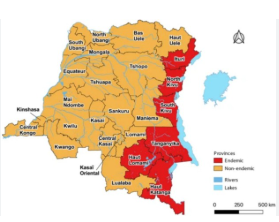Regional Spillover Risks of Conflict in Eastern DRC
The ongoing violence in the eastern Democratic Republic of the Congo (DRC) poses serious risks of spreading beyond its borders, threatening stability across Central and East Africa. Armed groups, ethnic rivalries, and foreign military involvement contribute to this instability. Additionally, displacement, arms trafficking, and economic disruptions could further escalate tensions in neighboring countries. This article explores the key ways in which the conflict in eastern DRC could spread regionally.
1. Cross-Border Rebel Movements
One of the primary risks of regional conflict escalation is the presence of armed groups with cross-border ties. Militant organizations such as the March 23 Movement (M23), the Allied Democratic Forces (ADF), and the Democratic Forces for the Liberation of Rwanda (FDLR) operate in and around the eastern DRC but have historical links to neighboring countries like Rwanda, Uganda, and Burundi. These groups frequently conduct attacks near border regions, leading to retaliatory operations that may pull multiple countries into a broader conflict. Rwanda and Uganda have previously been accused of supporting certain rebel factions, further complicating the situation. If these armed groups continue to gain strength, their activities could provoke cross-border military actions, increasing the risk of direct confrontations between states.
2. Ethnic and Political Tensions
Ethnic rivalries remain a key driver of violence in the region. The eastern DRC is home to a complex mix of ethnic communities, some of which have historical conflicts that extend into neighboring nations. The Rwandan government, for instance, has expressed concerns over the presence of Hutu extremist groups like the FDLR, which includes remnants of those responsible for the 1994 Rwandan genocide. Meanwhile, tensions between Hutu and Tutsi communities in the DRC, Burundi, and Rwanda continue to spark violence. If these ethnic conflicts escalate further, they could trigger a broader regional crisis, particularly if governments begin actively backing specific ethnic militias.
3. Involvement of Neighboring Militaries
The DRC’s neighbors, particularly Rwanda and Uganda, have historically intervened in Congolese conflicts. Rwanda has been accused of supporting the M23 rebel group, while Uganda has conducted military operations against the ADF inside Congolese territory. In response, the Congolese government has sought assistance from regional forces, such as the East African Community (EAC) military intervention. However, this involvement could backfire if tensions between regional armies escalate, leading to direct military confrontations. An extended conflict between the DRC and Rwanda, for example, could destabilize the entire Great Lakes region, drawing in more countries and intensifying violence.
4. Displacement and Refugee Crisis
The conflict in eastern DRC has already displaced millions, with many fleeing to neighboring countries such as Uganda, Rwanda, Tanzania, and Burundi. This large-scale displacement places enormous pressure on host nations, straining resources and heightening local tensions. In some cases, refugees are suspected of harboring militants, increasing security concerns for host governments. If the situation worsens, the refugee crisis could lead to increased hostility between nations, border closures, or even violent clashes over resource distribution.
5. Arms Trafficking and Organized Crime
Another major concern is the flow of illegal weapons and illicit goods across porous borders. Weak law enforcement in the region allows for arms trafficking, which fuels insurgencies and criminal networks. Rebel groups often finance their operations through smuggling minerals, drugs, and wildlife products. The spread of arms and criminal activity beyond the DRC’s borders could lead to rising violence in Uganda, Rwanda, Burundi, and even further into Tanzania and Kenya. Without strong international cooperation to curb illegal trade, the region risks a prolonged cycle of instability and insecurity.
6. Economic Disruptions and Resource Conflicts
The eastern DRC is rich in minerals, including cobalt, gold, and coltan, which are vital to global supply chains. The ongoing conflict disrupts mining operations, transportation routes, and trade with neighboring countries. Many of these minerals are smuggled across borders, fueling corruption and illicit trade networks. As a result, economic instability in the DRC has ripple effects on regional economies, particularly in Uganda and Rwanda, which rely on Congolese exports. Prolonged instability could lead to competition over resources, increasing tensions between states and potentially triggering further conflict.
7. Weak Regional and International Response
Despite various peacekeeping and diplomatic efforts, the international response to the crisis has been insufficient. The United Nations Organization Stabilization Mission in the DRC (MONUSCO) has struggled to contain violence, and regional mediation efforts have yielded limited results. The East African Community (EAC) deployed a military force to help stabilize eastern DRC, but internal divisions among member states weaken its effectiveness. Without stronger regional coordination and international pressure, the risk of the conflict escalating beyond the DRC’s borders remains high.
Conclusion
The ongoing violence in eastern DRC presents a serious threat to regional stability. Cross-border rebel activities, ethnic tensions, military interventions, and economic disruptions all contribute to the risk of conflict spreading to neighboring countries. Without decisive action from regional and international stakeholders, the situation could escalate into a broader crisis, affecting millions across Central and East Africa. A coordinated effort involving diplomatic negotiations, economic support, and security reforms is essential to preventing further regional destabilization.


Leave a Comment